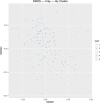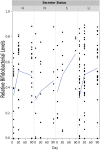The Fecal Microbial Community of Breast-fed Infants from Armenia and Georgia
- PMID: 28150690
- PMCID: PMC5288704
- DOI: 10.1038/srep40932
The Fecal Microbial Community of Breast-fed Infants from Armenia and Georgia
Abstract
Multiple factors help shape the infant intestinal microbiota early in life. Environmental conditions such as the presence of bioactive molecules from breast milk dictate gut microbial growth and survival. Infants also receive distinct, personalized, bacterial exposures leading to differential colonization. Microbial exposures and gut environmental conditions differ between infants in different locations, as does the typical microbial community structure in an infant's gut. Here we evaluate potential influences on the infant gut microbiota through a longitudinal study on cohorts of breast-fed infants from the neighboring countries of Armenia and Georgia, an area of the world for which the infant microbiome has not been previously investigated. Marker gene sequencing of 16S ribosomal genes revealed that the gut microbial communities of infants from these countries were dominated by bifidobacteria, were different from each other, and were marginally influenced by their mother's secretor status. Species-level differences in the bifidobacterial communities of each country and birth method were also observed. These community differences suggest that environmental variation between individuals in different locations may influence the gut microbiota of infants.
Conflict of interest statement
DAM is a co-founder of Evolve Biosystems, a company focused on diet-based manipulation of the gut microbiota. Evolve Biosystems played no role in the design, execution, interpretation, or publication of this study.
Figures




References
-
- Hanson L. A. et al. Protective factors in milk and the development of the immune system. Pediatrics 75, 172–176 (1985). - PubMed
-
- Brown E. M., Arrieta M.-C. & Finlay B. B. A fresh look at the hygiene hypothesis: how intestinal microbial exposure drives immune effector responses in atopic disease. Semin. Immunol. 25, 378–87 (2013). - PubMed
-
- Bäckhed F. et al. Defining a healthy human gut microbiome: current concepts, future directions, and clinical applications. Cell Host Microbe 12, 611–22 (2012). - PubMed
-
- Scholtens P. A. M. J., Oozeer R., Martin R., Amor K. Ben & Knol J. The Early Settlers: Intestinal Microbiology in Early Life. Annu. Rev. Food Sci. Technol. 3, 425–447 (2012). - PubMed
Publication types
MeSH terms
Substances
Grants and funding
LinkOut - more resources
Full Text Sources
Other Literature Sources
Medical
Molecular Biology Databases

